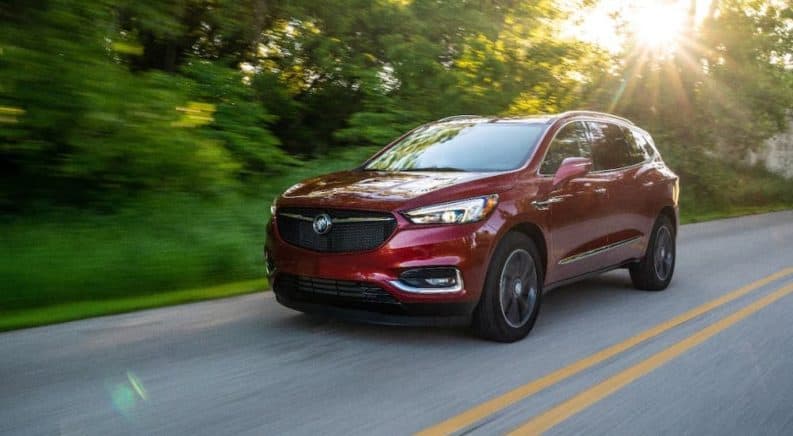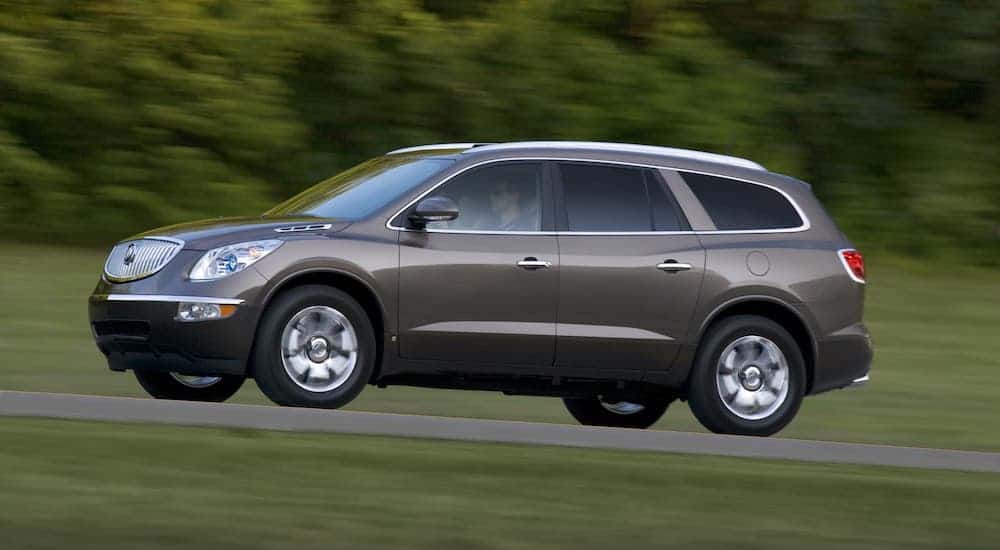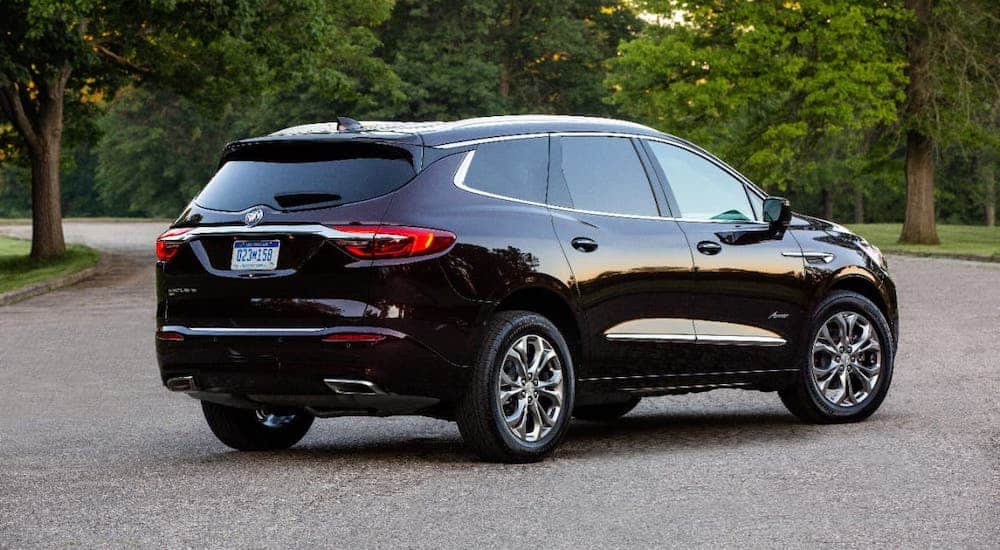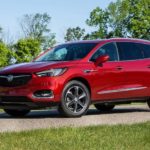The Buick Enclave is a large crossover SUV that has always been ahead of its time. From the first model in 2007 to the 2020 Buick Enclave, this car has consistently been an example of quality. To fully understand the depth of this vehicle’s impact on not only the Buick brand, but on the SUV segment as a whole, we’ll take a trip back in time and examine its lifetime of engineering and design innovations. We’ll also explore the features and characteristics that give it such a distinctive style. Let’s take a closer look at the 2020 Buick Enclave.
Buick Enclave: The History
In 2007, General Motors came out with the very first Buick Enclave. Ahead of its time, Buick’s first large crossover SUV sported a graceful design. This first-generation Enclave was around for nearly ten years (2008-2017) and needed minimal changes due to the car’s solid design and function. The vehicle was originally powered by a 275 horsepower 3.6-liter V-6 engine that was mated with a six-speed automatic transmission. But for the 2009 model, Buick upped the power and improved the engine to produce 288 horsepower, adding a much-needed power boost.
With this powerful engine and sleek design, the Enclave’s combined fuel economy was anywhere from 17 MPG to 19 MPG. All in all, the first-generation Enclave was a huge success for Buick and paved the way for the current 2020 Buick Enclave and all of its glory. Before we get to the newest model, let’s talk about the Buick Enclave’s first makeover. In 2017, Buick released the second-generation Enclave, revitalizing the aging, but still popular, model.
This new version was the first time Buick drastically changed the aesthetics of the Enclave. The egg-shaped design was scrapped, and though the new Enclave looked similar to the previous model, there were some obvious differences between the two. The vehicle’s body became sleeker and more modern looking, sporting a three-dimensional mesh grille with chrome wings. Additionally, the newer generation was upgraded with a nine-speed automatic transmission and a 310 horsepower engine. This newer model was also offered in three trim levels, including the premium Avenir trim line.
The 2020 Buick Enclave
Now that we’ve covered the history and evolution of the Buick Enclave, it’s time to talk about Buick’s peak model: the 2020 Buick Enclave. Starting at a modest $40,000, the 2020 Enclave seats up to 7 people. The Enclave sports a sleek, luxurious build and offers great fuel economy: 18 MPG in the city and 26 MPG on the highway. The 2020 Enclave is built for all your adventures, offering a maximum towing capability of 5,000 lbs. This car is truly versatile in the sense that you could bring it camping in the mountains, haul a huge trailer, or feel stylish pulling up to the valet for a night on the town.
Besides the basic features we’ve listed so far, the 2020 Buick Enclave goes above and beyond to keep its passengers safe and comfortable. This model includes advanced safety technologies such as lane change alert with side blind zone alert and automatic emergency braking. Coupled with state-of-the-art safety features, the 2020 Buick Enclave also incorporated thoughtful amenities, ensuring all your passengers are comfortable and happy.
Among these intuitive features is Apple CarPlay and Android Auto compatibility, as well as a built-in Wi-Fi hotspot with 4G LTE data available. When it comes to performance, the Enclave SUV is ready to roll with its 310 hp 3.6L V6 engine, available active twin-clutch intelligent all-wheel drive system, and a standard 9-speed automatic transmission. When it comes to the 2020 Enclave, you have four different trim levels.
Option 1: Preferred
- Starts at $40,000
- 310 horsepower 3.6L V6 engine
- Leather-wrapped steering wheel
- Buick Infotainment with color touch-screen
- QuietTuning technology
Option 2: Essence
- Starting at $42,000
- Leather-Appointed first and second-row seating
- Lange change alert with side blind zone detectors
- Rear cross-traffic alert
- In-Vehicle air ionizer
Option 3: Premium
- Starting at $48,000
- Bose Premium 10-speaker audio system
- Ventilated and massaging front seats
- Power-folding third-row seats
- Forward collision alert
Option 4: Avenir
- Starting at $53,800
- HD Surround Vision and Rear Camera Mirror
- Power Moonroof with rear fixed skylight
- Wireless smartphone charger
- Special exterior styling touches
How Buick Has Evolved
For all the automotive connoisseurs out there, it only seemed right to cover the history of Buick itself as well. Fun fact: Buick is currently the oldest North American automotive nameplate. In 1899, Buick was formed as the Buick Auto-Vim and Power Company (also making it one of the oldest automobile companies in the world). The company began as an independent internal combustion engine and motor-car maker but later was incorporated as the Buick Motor Company in 1903 by David Dunbar Buick in Detroit, Michigan.
In that same year, the company was bought by James Whiting, who brought in William Durant to manage the acquisition. Durant then partnered with R S McLaughlin in Canada in 1907 with a 15-year contract and created “Canada’s Standard Car.” He was a natural marketer and salesman, quickly building Buick to be the biggest car manufacturer in America. Using these profits, Durant acquired a series of companies and founded a new megacorporation – General Motors.
At first, the car makers comprising this megacorporation competed with one another. Seeing the insensibility of this, Durant put a stop to it. Instead of competing with each other, Durant decided that each car maker within General Motors would target a different class of customers. Of the many General Motors brands, Buick still occupies one of the highest target markets, second only to Cadillac.
Buick cars are meant to target upper-middle-class people who perhaps aren’t quite well off enough to afford a Cadillac. Though many believe Ford to be the most advanced car manufacturer of the early 1900s, Buick was actually the first brand to introduce a closed-body car in 1911 (a whole four years ahead of Ford). Another fun fact – In the 1930s, Buicks were fancied by the British royal family, particularly Edward VIII. He shipped in and used a Canadian built McLaughlin-Buick when that was GM’s top brand in Canada, Cadillac not having caught on there quite yet. Additionally, George VI used one for a coast to coast royal tour of Canada in 1939.
Another milestone for Buick was the introduction of VentiPorts. A traditional Buick styling cue, VentiPorts are a series of three or four vents on the front fender behind the wheels. This trend originated with a custom car for Ned Nickles, a Buick stylist. Though VentiPorts remained a nonfunctional ornament on Buicks, their name originated from a 1949 sales brochure that claimed they helped to ventilate the engine compartment to prevent overheating.
While the jury is out as to whether the VentiPorts actually provided a cooling benefit, they ended up being a bit disruptive because Buick owners often complained that their children stuffed the holes full of various objects. Luckily (or unluckily), Buick sealed the VentiPort holes but kept the ornamental look to continue the signature styling.
Beginning in the late 1950s, Buick’s sales quickly started to decline. The trifecta of the brand going out of style, reliability issues, and buyers’ interest in smaller, more fuel-efficient vehicles combined with plummeting sales from nearly 350,000 vehicles sold at its high to a scant 150,000. It was time for Buick to make some changes and adapt to current consumer demands.
Luckily, after a period of revamping its cars and marketing activities, Buick bounced back. Buick was intent on serving notice that it would keep on improving its reputation for brand quality, and that paid off with vehicles like the Buick Enclave. Generally, that has been true for over 90 years, since the days when David Buick, Eugene Richard, and Walter Marr introduced the original Buick valve-in-head motor, even before Billy Durant utilized Buick to construct what turned into the biggest automaker ever — General Motors.






